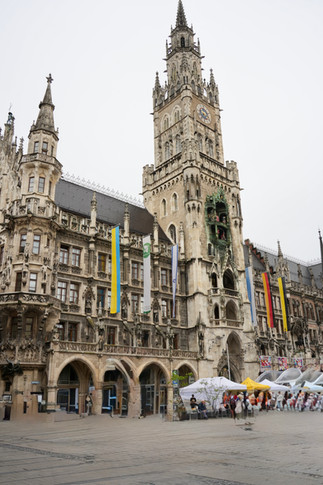MUNICH: HISTORY
- chuckmeltzer
- Jul 17
- 3 min read
Updated: Aug 26
Munich, established in 1158, serves as the capital of Bavaria, one of Germany's 16 states. Throughout its history, Munich has been a significant center for culture, politics, and economics. The city boasts numerous historic buildings, although many were destroyed by Allied bombings during WWII and have since been reconstructed, similar to other cities we've visited on our tour.
We like to begin our visits to each city with a half-day tour. Once again, we chose ToursByLocals. We met our guide, Stefan, a knowledgeable young man. He grew up in Munich and has traveled extensively. He studied history in college and is well-versed in his subject, bringing additional materials to enrich the storytelling. We started our tour through the old town, and first visited St. Peter's Church, a Roman Catholic parish church from 1368.

Afterwards, it began to rain heavily, therefore we followed the local custom and headed to Augustiner Beer Garden for a beer, which Stefan recommended as being less touristy than Hofbrauhaus. I had a schnit, which is smaller portion than a .5 liter and just the right amount at 3PM.
While we were enjoying our beer, Stefan delved into the complex history surrounding the emergence of the Nazi Party, highlighting its profound relevance to the political landscape of early 20th-century Germany. He explained how Adolf Hitler, a young man originally from Austria, arrived in Munich with aspirations of becoming an artist, but instead found himself drawn into the chaotic political environment of the time. Without going through all the intricate details of his early life, it is essential to understand that this very city became the crucible for his malevolent ideology and the eventual rise to power of the Nazi Party.
The beer gardens, which were an integral part of Bavarian culture, held significant social and political importance during that era. They were not merely venues for enjoying a pint of lager; they served as communal gathering spots where people from various walks of life came together to discuss ideas, share grievances, and engage in heated debates. This social dynamic created an environment ripe for political discourse and mobilization. It was within these lively settings that Hitler and his associates could effectively spread their propaganda, rally supporters, and cultivate a sense of camaraderie among those who felt disillusioned by the prevailing socio-economic conditions.
Stefan emphasized that the beer gardens were instrumental in fostering a sense of community among the disenfranchised, providing a platform for the Nazi Party to gain traction among the populace. The combination of the intoxicating atmosphere and the fervent discussions allowed for the rapid dissemination of radical ideas, which resonated with many who were eager for change in a nation grappling with the aftermath of World War I and the Treaty of Versailles. The ability of the Nazis to capitalize on the collective frustrations of the people, while simultaneously utilizing these social hubs for their political gain, cannot be overstated. In essence, the beer gardens were not just a backdrop for Hitler's rise; they were a vital component in the orchestration of his political strategy. The very act of sharing a beer became intertwined with the sharing of ideologies, leading to the mobilization of support that would eventually culminate in the establishment of a regime that would have catastrophic consequences for millions. Thus, as we sipped our drinks, we were reminded of the historical weight that such seemingly innocuous places carried, serving as a stark reminder of how quickly a society can be swayed toward darkness.
The old town features typical attractions such as the open-air Viktualienmarkt and the town hall located on Marienplatz. Marienplatz serves as the town square and is a pedestrian area, making it a pleasant place for walking. The Theatine Church, built between 1663 and 1688, is an example of late Baroque architecture.


There is an alley in which there are lighter colored cobblestones winding their way known as Viscardigasse, or Dodgers' Alley. This alley served as a discrete route for residents during the Nazi regime who wished to avoid passing by the nearby Feldherrnhalle monument in Odeonsplatz and being forced to give the Nazi salute. The monument commemorated the Nazis killed during the 1923 Beer Hall Putsch.

Honestly, we've become somewhat amateur experts, if that's possible, in gothic, baroque, and rococo styles. So, exploring the old town was pleasant, though somewhat repetitive. Moreover, while a few buildings survived the bombings, most of them don't date back hundreds of years, as they were reconstructed after WWII.







































Comments